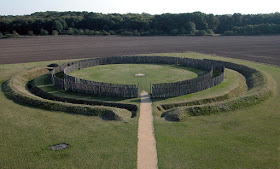The archaic...the arcane...and fantastic...the historic...Compiled from divers sources.
Pages
▼
Monday, February 29, 2016
Goseck Circle: The Oldest Known Solar Observatory
In 1991, inspectors from the German government took aerial photographs of a small German town called Goseck and saw something strange. On the ground, there appeared to be a giant circular ridge hidden beneath a field. It would take archaeologists 12 years to realize that this ridge was the remains of an ancient solar observatory. Archaeologists also found the remnants of ritual fires and human bones with cut marks on them indicating that the circle was not just for star gazing but also for human sacrifice. Curiously, a 3,600 year old bronze disc was discovered just 25 kilometers away from the site and is considered to be the oldest concrete representation of the cosmos. It shares a striking similarity with Goseck Circle.
Goseck Circle – A Neolithic henge
Goseck Circle or Goseck Henge, is an early Neolithic Henge structure with entrances orientated to the rising and setting solstices. It was apparently created by Europe's first civilization, long before the cultures of Mesopotamia and the pyramids of Egypt. Dubbed the German Stonehenge, the structure has been radiocarbon dated to 4900 BC. Hundreds of similar wooden circular ridges just like it were built during a 200 year period around the same time. It is one of the best studied of the more than 250 ring ditches identified by aerial surveys throughout Germany, Austria, the Czech Republic, Slovenia and Croatia. Previously, archaeologists had thought that these henges might have simply been ancient fortifications.
Constructed by a mysterious culture
The people who built Goseck Circle are known only as the Stroke-Ornamented Ware Culture from the fragments of pottery they left behind. Various pottery shards belonging to this culture were dug out from the site and date back to around 4700 B.C. The discovery of the shards also suggests that the site was functional for a period of 200 years and then abandoned. They represent a transition from Neolithic linear pottery to Stroke-Ornamented Ware Culture. The jars and bowls had their decorations jabbed into the soft clay with a kind of fork to form zig-zag lines. Archaeologists know nothing about the appearance or language of the people who built Goseck and can only surmise what their religious beliefs might have been. Some claim the circle was a calendar that told ancient farmers in the area when it was time to begin counting the days until spring planting. However, excavations of the 6,000 square-meter site have also found the remains of headless skeletons, human and animal bones, decapitated oxen and ritual fires all pointing towards burial rituals or human sacrifice.
READ MORE
Connection with the Nebra Sky DiskOne of the most interesting aspects of Goseck Circle is the fact that the roughly 100 degree span between the solstice gates corresponds with an angle on a bronze disk unearthed 25 kilometers (15 miles) away, near the town of Nebra, Germany. The Nebra Sky Disk, measuring 32 centimeters in diameter, dates from 1600 BC and is the oldest portable representation of the cosmos found to date. It depicts a crescent moon, a circle that was probably a full moon and a cluster of seven stars interpreted to be the Pleiades constellation as it appeared 3,600 years ago (almost 2,000 years after the Goseck Circle). Scattered on the object are other stars, three arcs, all picked out in gold leaf from a violet-blue background.
The striking connection between Goseck and the Nebra Sky Disk is the fact that angle formed between the midsummer and midwinter sunrise at Goseck is 82 degrees, exactly the same angle as the horizon lines marked on the Nebra Disk. Two opposing arcs run along the rim of the disk. The lowest points are 97.5 degrees apart and signify the sunrise and sunset on the winter solstice in central Germany at the time. Likewise, the uppermost points mark the sunrise and sunset on the summer solstice. The sun's position at solstice has shifted slightly over the past millennia, notes Wolfhard Schlosser of the Ruhr University in Bochum, so that the angle between sunrise and sunset is now slightly farther apart than when the Nebra disk and the Goseck circle were made (by 1.6 and 2.8 degrees, respectively).


No comments:
Post a Comment
Note: Only a member of this blog may post a comment.